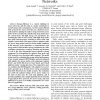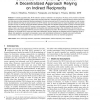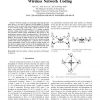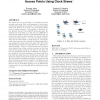110
Voted
TMC
2010
14 years 11 months ago
2010
—IEEE 802.16 standard was designed to support the bandwidth demanding applications with quality of service (QoS). Bandwidth is reserved for each application to ensure the QoS. Fo...
113
click to vote
TMC
2010
14 years 11 months ago
2010
—Evaluating and quantifying trust stimulates collaboration in mobile ad hoc networks (MANETs). Many existing reputation systems sharply divide the trust value into right or wrong...
128
Voted
TMC
2010
14 years 11 months ago
2010
—Energy-efficiency is a central challenge in sensor networks, and the radio is a major contributor to overall energy node consumption. Current energy-efficient MAC protocols fo...
TMC
2010
14 years 11 months ago
2010
—Compromised-node and denial-of-service are two key attacks in wireless sensor networks (WSNs). In this paper, we study routing mechanisms that circumvent (bypass) black holes fo...
117
Voted
TMC
2010
14 years 11 months ago
2010
—Wireless sensor networks have been used to gather data and information in many diverse application settings. The capacity of such networks remains a fundamental obstacle toward ...
93
Voted
TMC
2010
14 years 11 months ago
2010
—In densely populated cities, Wi-Fi networks—private or otherwise—are ubiquitous. We focus on the provision of citywide broadband communication capability to mobile users thr...
96
Voted
TMC
2010
14 years 11 months ago
2010
—Network coding is an attracting technology that has been shown to be able to improve the throughput of wireless networks. However, there still lacks fundamental understanding on...
106
Voted
TMC
2010
14 years 11 months ago
2010
—This paper deals with decentralized, QoS-aware middleware for checkpointing arrangement in Mobile Grid (MoG) computing systems. Checkpointing is more crucial in MoG systems than...
114
click to vote
TMC
2010
14 years 11 months ago
2010
—To make a network last beyond the lifetime of an individual sensor, redundant sensors must be deployed. What sleep-wakeup schedule can then be used for individual sensors so tha...
141
click to vote
TMC
2010
14 years 11 months ago
2010
We explore the use of clock skew of a wireless local area network access point (AP) as its fingerprint to detect unauthorized APs quickly and accurately. The main goal behind usi...




